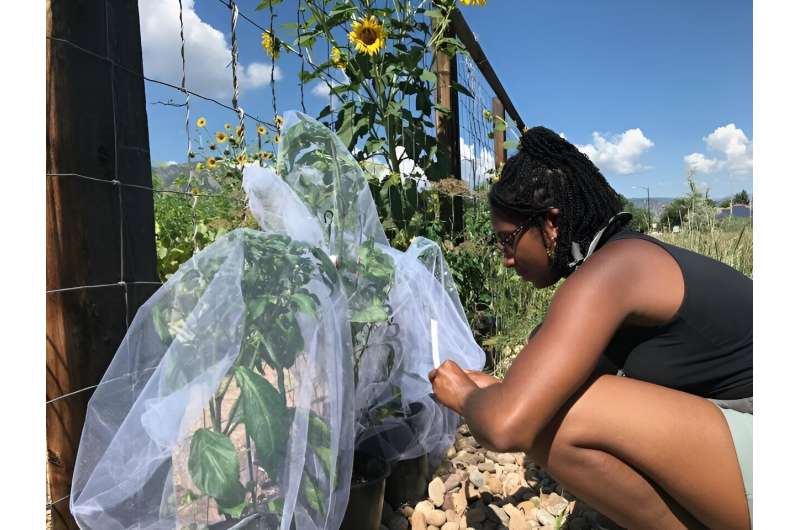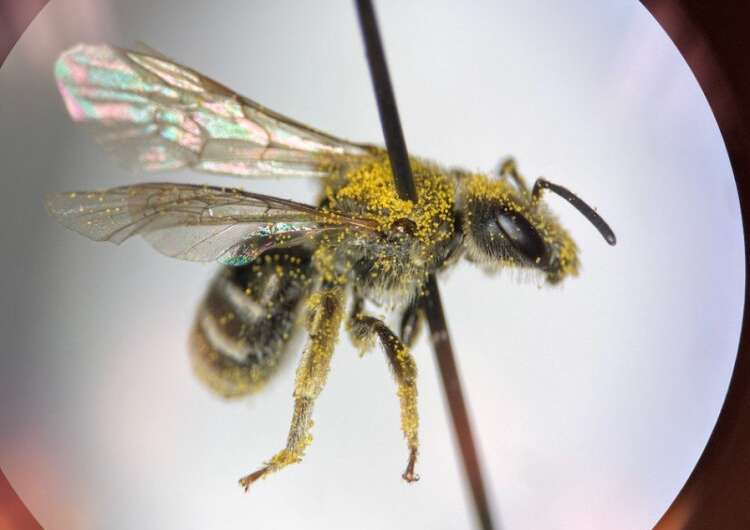This article has been reviewed according to Science X's editorial process and policies. Editors have highlighted the following attributes while ensuring the content's credibility:
fact-checked
trusted source
proofread
Wealthier neighborhoods in Boulder saw lower bee diversity

Community gardens in higher-income Boulder neighborhoods have fewer varieties of bees than their medium-income counterparts, new CU Boulder research suggests. Scientists suggest that people in these neighborhoods tend to apply more landscaping practices, such as using fertilizers, which could impact bees' habitats.
The finding appeared May 22 in the journal Urban Ecosystems.
"Bees are so important for local ecosystems through their pollination services. The landscape would not look the same without our pollinators," said Asia Kaiser, a doctoral student in the Department of Ecology and Evolutionary Biology at CU Boulder.
The result came as a surprise to Kaiser and Julian Resasco, assistant professor in the Department of Ecology and Evolutionary Biology and the paper's senior author, because it contradicted previous studies.
Prior research showed that wealthier urban neighborhoods tend to have more trees and green space. As a result, a greater diversity of animal species tends to live in these areas, a pattern called the luxury effect.
Ecologists Kaiser and Resasco wanted to explore how insects in urban gardens respond to the neighborhoods that surround them. Specifically, they are interested in how the urban environment could affect insects like bees that pollinate garden crops.
The jalapeño test
Last spring, the team planted about 70 jalapeño pepper plants in seven large community gardens across Boulder and Louisville. Using traps, the team collected more than 3,000 insects and other arthropods such as spiders from the gardens.
The researchers found that neighborhoods with more artificial structures—pavement, roads and rooftops that prevent water from soaking into the ground—had lower numbers of pollinators. At the same time, wealthier neighborhoods had fewer species of bees.

Landscaping practices and the type of plants that are more common in wealthier neighborhoods may contribute to lower bee biodiversity, Kaiser said. These communities tend to have more mature trees, which are different from plants found in native bees' habitats. People living in these neighborhoods may also use more pesticides, fertilizers, water and mulch to support these plants, creating worse soil conditions for bees to nest in.
"Most of the bees found in these gardens, such as long-horn bees and squash bees, nest in the ground, so they are sensitive to changes in the soil," Kaiser said.
In addition, the jalapeño pepper fruits grew larger in gardens with higher bee diversity, suggesting the important role that pollinators play in ecosystems.
Other arthropods—including pests like beetles and pest-eating predators like spiders—thrived in wealthier neighborhoods, the team found. It remains unclear why these critters were doing well, but Kaiser suspected they might be benefiting from the abundant food sources in the urban gardens.
"It's interesting that different animal groups are being impacted by different features of the urban environment," Kaiser said.
She added that Colorado residents can plant more native plants and provide natural cover such as bare soil and downed wood for insects to nest in to promote bee diversity.
Urban oases
Next, the team plans to expand the experiments to community gardens in Denver. This will allow them to evaluate pollinator diversity in neighborhoods with a wider range of urbanization and socioeconomic status, including lower-income areas.
"Urban community gardens can be really important sources of nutrition in cities where nutritious food is often hard to come by," Resasco said. "Understanding how different aspects of urbanization affect arthropod biodiversity and how that in turn affects the yield of these crops is very important."
More information: Asia Kaiser et al, The impact of impervious surface and neighborhood wealth on arthropod biodiversity and ecosystem services in community gardens, Urban Ecosystems (2024). DOI: 10.1007/s11252-024-01560-y
Provided by University of Colorado at Boulder





















